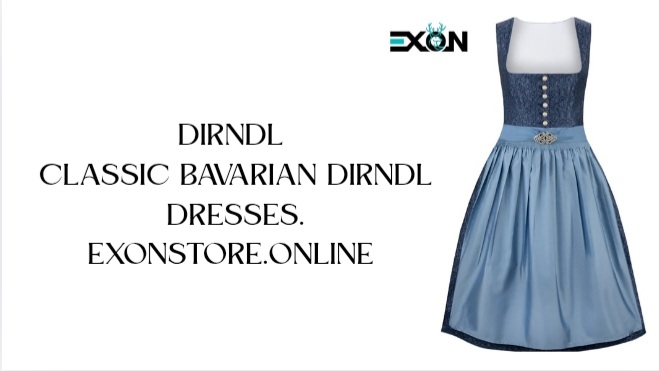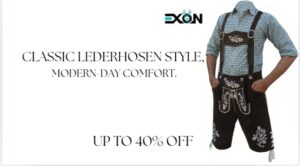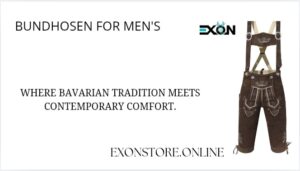When it comes to traditional Bavarian attire, few garments capture the essence of heritage and elegance quite like the dirndl dress.
This iconic outfit, worn for centuries in Germany, Austria, and other Alpine regions, has transformed from a simple work dress into a fashion statement that embodies femininity, tradition, and style.
Today, dirndl dresses are not only cherished for cultural festivals like Oktoberfest but also appreciated worldwide for their graceful design and versatile charm.
A Brief History of the Dirndl
The origins of the dirndl dress trace back to the 19th century, when it was primarily worn by Austrian and Bavarian women working in farms and households.
Designed for practicality, these dresses consisted of a blouse, bodice, skirt, and apron, allowing freedom of movement while maintaining modesty. Over time, the dirndl evolved into a festive and decorative garment, adorned with embroidery, lace, and high-quality fabrics.
By the late 19th and early 20th centuries, the dirndl became a symbol of national pride, gaining popularity among the middle and upper classes who began to wear it for special occasions.
Anatomy of a Dirndl Dress
A classic dirndl consists of four main components, each contributing to its iconic silhouette:
- Blouse – Usually white and cropped, the blouse features puffed sleeves and a neckline that can vary from modest to daring, depending on personal preference.
- Bodice – The fitted bodice shapes the torso and often includes decorative lacing, buttons, or embroidery, adding to the dress’s unique charm.
- Skirt – Falling anywhere between knee-length and ankle-length, the skirt provides flow and grace, making the dress suitable for both casual and formal settings.
- Apron – Worn over the skirt, the apron not only enhances the beauty of the outfit but also carries traditional symbolism. The position of the apron bow signals the wearer’s relationship status—tied on the left means single, on the right means married or taken, and in the middle suggests uncertainty or virginity.
This balance of tradition and symbolism gives the dirndl a deeper cultural meaning beyond its aesthetic appeal.
Modern Variations and Styles
Today’s dirndl dresses come in a wide range of designs, fabrics, and colors, catering to diverse tastes.
While some women prefer the classic, long dirndls made of cotton or linen, others gravitate toward shorter, modern versions crafted from luxurious materials like silk, velvet, or satin.
Designers often play with bold prints, vibrant hues, and intricate embellishments, creating a contemporary twist on the traditional attire.
From understated elegance to dazzling glamour, dirndls can be styled for various occasions.
A simple cotton dirndl with minimal detailing works perfectly for casual gatherings or daytime festivals, while a richly embroidered, floor-length silk dirndl is ideal for weddings, galas, or formal celebrations.
This versatility is one reason dirndl dresses continue to thrive in modern fashion.
Why Dirndl Dresses Remain Popular
The enduring appeal of dirndl dresses lies in their ability to merge tradition with modern fashion trends. Here are a few reasons why they remain timeless:
- Cultural Identity: Wearing a dirndl allows women to connect with Bavarian and Alpine traditions, especially during Oktoberfest and regional festivals.
- Flattering Silhouette: The fitted bodice and flowing skirt flatter nearly every body type, highlighting femininity without compromising comfort.
- Versatility: With countless variations in length, fabric, and detailing, dirndls can be styled for casual, festive, or formal settings.
- Symbolism: The placement of the apron bow adds an element of communication and tradition that makes the outfit even more meaningful.
Styling Tips for a Dirndl
For those new to wearing dirndl dresses, styling can elevate the entire look. Pairing the outfit with traditional accessories such as edelweiss jewelry, chokers, or floral crowns enhances authenticity.
Comfortable yet stylish shoes like ballet flats, low heels, or traditional Bavarian shoes (Haferlschuhe) complete the outfit.
Adding a shawl or cardigan not only provides warmth but also adds a touch of elegance, especially during cooler weather.
When selecting a dirndl, it’s important to choose colors and fabrics that suit the occasion.
Bright, playful shades are perfect for festivals, while darker or jewel-toned dresses work better for evening events.
Ultimately, personal comfort and confidence are key to carrying the dirndl with grace.
The Global Influence of Dirndl Fashion
Though deeply rooted in Bavarian and Austrian culture, dirndl dresses have gained international recognition, largely thanks to the global popularity of Oktoberfest celebrations.
Visitors from all over the world embrace the tradition of wearing dirndls and lederhosen, bringing the spirit of Alpine culture to new regions.
Fashion designers across Europe and beyond have also incorporated dirndl-inspired elements into contemporary collections, proving its influence on global style.
Conclusion
The dirndl dress is far more than a piece of clothing—it is a cultural emblem that celebrates tradition, femininity, and timeless beauty.
From its humble beginnings as a work dress to its current status as a fashionable and symbolic garment, the dirndl has stood the test of time.
Its ability to adapt to modern trends while preserving its heritage makes it a cherished outfit for women across the world. Whether worn at Oktoberfest, a wedding, or simply as a statement of cultural pride, the dirndl dress continues to embody elegance and tradition in every stitch.







